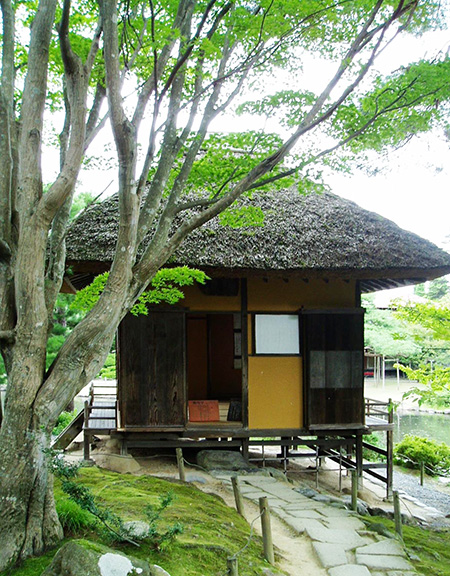

押板から床、そして床の間へと掛け軸絵画鑑賞の空間が
日本人の中で進化していった過程の先に茶室もあるように思える。
押板段階から掛け軸画は中国由来のものが多数派だったとされる。
そういう掛け軸を掛けて鑑賞するのに、背景としての最適化を
美意識の向かう必然的方向性として進めていって
やがて床の間に至ったという流れなのでしょう。
押板と床の間の違いの最たるものは床面が広がったことで、
そこに華道を生む「花を生ける」用途空間も生み出されていった。
中国の掛け軸は詩と絵が一体となっているとされ、
そういう文字の読みくだしと絵画鑑賞がワンセットで
床の間・押板空間に於いて日本人社会に染みわたっていった。
それはなによりも「異国情緒」でもあったように思う。
掛け軸画のテーマは主に中国の土地風景であり、
それを鑑賞するには集団知が必要だったに違いない。
「この絵は中国の名所◎◎の秋の景色で・・・」
「で、都での政争に敗れた◎◎が遙かな都の春の思いを・・・」
というような解説を開陳する先導者の話を聞きながら、
「おお、そういう気持ちを表現するのが芸術というものか」
というように「読みくだし」を共有し合った、という風景が思い浮かぶ。
で、そういう「寄り合い」の場に茶が出されていた。
日本のムラ社会であれば麦焦がしなどがふつうであっただろうけれど、
そういう場で、やがて緑茶というものがふるまわれていった・・・。
お茶の栽培は平安末から鎌倉初期の僧・栄西(1141年ー1215年)が、
中国より持ち帰った種子を佐賀県脊振山に植えたのが始まり。
かれは日本における臨済宗の開祖、建仁寺の開山。
当時のお茶は蒸した茶葉を揉まずに乾燥させた碾茶=てんちゃで、
社交の道具として普及したものとされる。
この国の「文化の伝播」のルートとして宗教が果たした役割がわかり、
そして茶というものがその媒介であったこともわかる。
やがてその喫茶において茶器などの「数寄」が始まっていく。
「この茶碗は、ルソンという日本のはるか南の島で焼かれたもので」
というように各地のムラ共同体での交流が活発化していった・・・。
人口の増加、生産活動の活発化という社会発展があって、
人々の暮らしの中に「余暇」という時間観念が広がっていったときに
まずは宗教的な先達者がいて、その周辺に喫茶習慣が広がり
それが建築の特異な表現として茶室へと昇華していった。
はじめは世界の文化への興味、知識欲なりが初源だったものが、
やがて日本独自の文化現象、建築の特異な発展という結果に繋がる。
どうもそのような想像力が自然な文化理解ではないかと。
そのように考えて行くとき、押板〜床の間と茶室には
ある生活文化的な強い関連性があるのではないかと思われる。
なぜ日本家屋の間取りで「茶の間」という名前が
もっとも娯楽的で家族関係の醸成の場として中核位置を占めたのか、
言語発展の道程としてみても、興味深いと思うところです。
English version⬇
[Leap from Tokonoma Art Appreciation-Tea Room]
From the Oshiita to the floor and between the floors, there is a space for viewing hanging scroll paintings.
It seems that there is a tea room ahead of the process of evolution among the Japanese.
It is said that the majority of hanging scroll paintings were from China from the pressing stage.
Optimizing as a background for viewing with such a hanging scroll
Proceeding as an inevitable direction for aesthetics
Perhaps it was a flow that eventually reached the alcove.
The biggest difference between the Oshiita and the floor is that the floor surface has expanded.
There was also a space for “flower arrangement” to create flower arrangement.
Chinese hanging scrolls are said to be a combination of poetry and painting.
One set of reading such characters and appreciating paintings
It permeated the Japanese society in the alcove and the push board space.
I think it was also “exoticism” above all.
The theme of the hanging scroll painting is mainly the land landscape of China,
It must have required collective wisdom to appreciate it.
“This picture is a famous place in China ◎◎ in the autumn scenery …”
“So, ◎◎ lost the political conflict in the city, but the feelings of spring in the far city …”
While listening to the story of the leader who opens the commentary like
“Oh, is it art to express that feeling?”
I can think of a landscape where we shared such “reading”.
So, tea was served in such a place of “closeness”.
In Japan’s uneven society, it would have been normal to burn wheat, but
Under such circumstances, green tea was eventually served …
Tea was cultivated by Eisai (1141-1215), a monk from the end of the Heian period to the early Kamakura period.
He started planting seeds brought back from China on Mt. Sefuri, Saga Prefecture.
He was the founder of the Rinzai sect in Japan, the founder of Kenninji Temple.
The tea at that time was Tencha, which was made by drying steamed tea leaves without rubbing them.
It is said to have become popular as a social tool.
I understand the role that religion played as the route of “cultural diffusion” in this country.
And we can see that tea was the medium.
Eventually, “Sakuyori” such as tea ware will begin at the coffee shop.
“This bowl was baked on Luzon, an island far south of Japan.”
In this way, exchanges in the Mura community in each region became more active.
With social development such as population growth and active production activities,
When the idea of ”leisure” spreads in people’s lives
First of all, there are religious pioneers, and coffee habits spread around them.
It sublimated into a tea room as a peculiar expression of architecture.
At first, the first source was interest in world culture and desire for knowledge.
Eventually, it will lead to the result of Japan’s unique cultural phenomenon and the unique development of architecture.
I wonder if such imagination is a natural understanding of culture.
When thinking that way, between the push plate and the alcove and in the tea room
It seems that there is a strong cultural relevance.
Why is the name “Cha no Ma” in the floor plan of a Japanese house?
Did it occupy the core position as the most entertaining and fostering place for family relationships?
It’s also interesting as a path to language development.
Posted on 4月 23rd, 2021 by 三木 奎吾
Filed under: 住宅マーケティング, 日本社会・文化研究, 歴史探訪







コメントを投稿
「※誹謗中傷や、悪意のある書き込み、営利目的などのコメントを防ぐために、投稿された全てのコメントは一時的に保留されますのでご了承ください。」
You must be logged in to post a comment.